
Original Link: https://www.anandtech.com/show/2433
PC Power & Cooling Turbo Cool 860W: Special AnandTech Edition
by Christoph Katzer on February 4, 2008 2:00 AM EST- Posted in
- Cases/Cooling/PSUs
Introduction
A short while ago, PC Power & Cooling (PCP&C) revealed its latest addition to their portfolio: the Turbo Cool 860W. It does not use the same topology as the 1000W and 1200W power supplies from the same series, which we will see later when we open the unit up. Today we will be looking at a special unit we received from PCP&C. The company was nice enough to build a special edition PSU that includes extra cable harnesses and connectors - all according to our specifications. Our unit is ready for Triple-SLI with six 6-pin PEG connectors, three of which also perform double duty as 8-pin PEG connectors. On top of that, we asked for 15 SATA connectors to power up some special tests we will be working on this year.

We met PCP&C founder Doug Dodson at this year's CES in Las Vegas; we had the chance to conduct an interview with him that we will publish soon as well. With the 860W version of the Turbo Cool series, PCP&C again targets the higher-end enthusiast market with the need for long lasting industrial standard power supplies. One special feature is the three small potentiometers that allow the user to tune the voltage regulation of the 3.3, 5, and 12V rails.

The label shows PCP&C's general approach to power supplies. We see a single 12V rail, which according to Doug is the best solution for power supplies. We are still waiting for our 15 hard-drives to arrive, but we have talked with at least one AnandTech reader that successfully powered up 18 hard-drives with a single-rail Silencer 750W where all multi-rail power supplies failed. The 12V rail provides a total of 64A and consumes up to 768W of power. In fact, the peak power is around 840W solely on the 12V rail, and our unit was able to reach 967W peak power during the tests. The 3.3 and 5V rails are rather small with only 22A and 26A, but that shouldn't be a problem.
Package and Appearance

The power supply comes in a color box just like the new one of the Silencer 750 QUAD. It is securely held inside of the box to protect it while shipping. The power unit itself comes in a matte black color. An 80mm Delta Electronics fan is located at the front of the power supply. During operation the air will come through openings in the front of the PSU as well as through the venting holes on both sides - the side vents help to cool the transformer among other components.

PCP&C uses the same sort of fan that we saw in the Turbo Cool 1200W power supply: a very noisy Delta Electronics fan that can reach speeds of up to 5000RPM. While the fan runs is rated at the same speed as before, we measured slightly lower noise levels than the 1200W version (most likely the result of dissipating 340W less power, though changes in the internal layout may also play a role).
Cables and Connectors


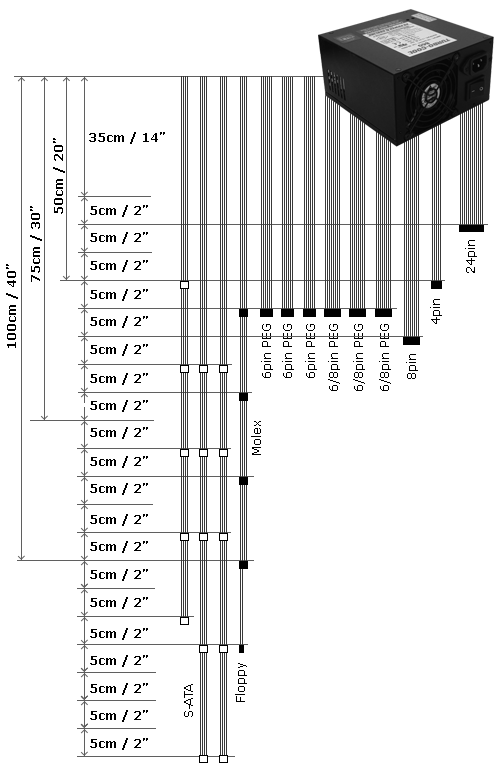
The length of the harnesses is quite long. Shorter harnesses would have also sufficed, as we plan to connect them all to our upcoming disk array. We asked a case manufacturer to supply us with a proper housing for the array, and we will get a custom-made case for this purpose very soon. We have an interview with Doug Dodson that we will post shortly that will help explain how this PSU is different from anything else on the market. The standard 860W Turbo Cool will not have the same amount of cables and connectors, since PCP&C didn't feel there was a sufficient market for that sort of product, but with four PEG connectors and 15 Molex and SATA connectors the power supply is well-equipped for the higher-end enthusiast market.

Our 15 SATA connectors come via three cable harnesses, each up to 125cm long (approximately 50 inches).
Internals
We have criticized the Turbo Cool series previously. The problem wasn't so much with performance as it was with a disagreement about the internal construction. The 860W version of this series has a totally different design, which is definitely a good thing in our view. That this power supply is far more than a minor modification of the previous Turbo Cool models is clearly visible once you open it up. The topology is not a standard design where we can easily find the primary and secondary parts.

We have a nicely built filtering stage at the left side that leads to the rectifier bridge, which connects to a copper heatsink. We also see parts of the primary side and the main capacitor with the blue circle (made by Hitachi) located at the center of the left side. Incoming power then travels to the upper right side and goes down the right side into the main transformer located in the lower right corner of the power supply. The secondary part starts with the heatsink located in the lower middle.


The capacitors from the secondary side sit right below the outgoing cables. Also quite recognizable are the three potentiometers connected to the vertical mounted sister-PCB on the lower left side of the power supply. All of the components used throughout the power supply are top-quality parts.
Internals, Cont'd

Once we dismounted the copper plate that connects the right aluminum heatsink and the center copper heatsinks, we could see what was under it. The copper heatsinks (or copper plates) are mounted there because of the limited space between the chokes and the capacitor. Copper has a much better heat conductance than aluminum, which is necessary since the volume and size of the small heatsinks are limited. The bridge to the aluminum heatsink helps to dissipate some of the heat, but more importantly it transports heat to the other larger heatsink.



More Internals

The small PCB connected to the secondary heatsink contains the fan control. There is a temperature diode connected to the control PCB that sits right beside the secondary heatsink. The fan control works better in this unit than in other Turbo Cool PSUs we've looked at, but the demands aren't as high as this unit delivers less power than its bigger brothers do.

A large sister
PCB sits vertically on the main PCB. On it are the potentiometers that users
can use to adjust the output regulation of the three main rails. It must be difficult
to get the cables through the opening when the assembler is getting the PCB into
the housing. Between the housing and the sister PCB there is little space, which
is why PCP&C holds the PCB in line with a cable-tie. According to PC Power the cable-tie will just appear in our version since the mass of cables are pushing against the PCB.


Test Setup, Output Stability, and Ripple Noise
As always, we have tested this power supply with our Chroma ATE. The Chroma enables us to put a specific amount of load to each of the rails.
Note: If you would like to know more about our testing methodology, equipment, and environment, please read our PSU testing overview.
We have added an additional 10% on the highest load to see how the units handle overload situations. We continue to use this test as a worst-case scenario. The overload test will starts at room temperature, and to avoid being too cruel we keep the ambient temperature at a maximum of 50°C. Experience shows that many units can stand the overload in room temperature but will show problems with higher temperature and overload together. Only the best units will survive this test without any difficulties.

DC-Outputs
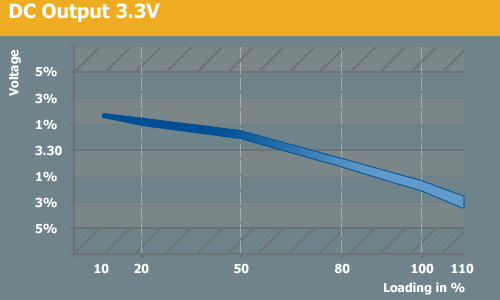
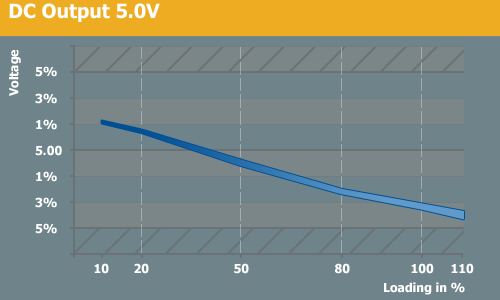
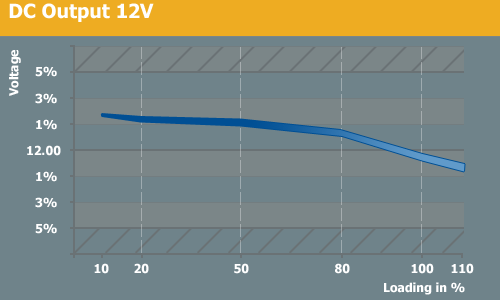
The stability of the 12V rail is quite impressive showing only a 2% deviation. The lower voltage 3.3V and 5V rails are a little higher with a little over 4% of regulation. The measured ripple/noise were very impressive with the 12V rail and is about 2.8mV under average load measured at 230VAC. The other rails perform well, with only slightly higher results.
Efficiency and PFC
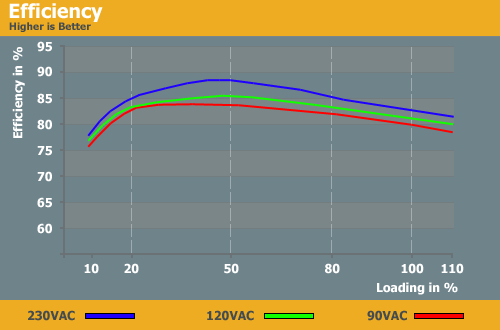
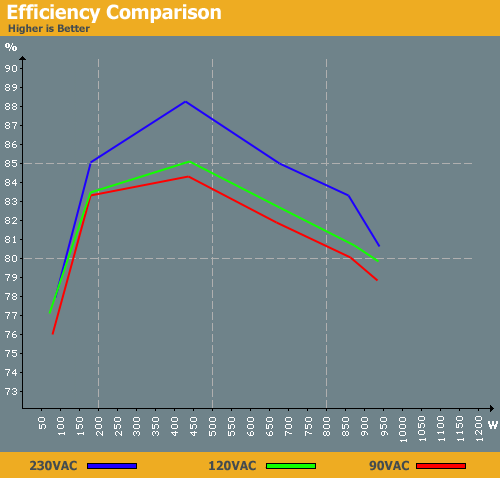
The efficiency is very impressive even though we have to say we were a little disappointed since the delivered test report of PCP&C showed 86% efficiency at full load. The sheet shows an output of 886W with an input of 1030W. With our loading table, we didn't reach 886W since it is only an 860W power supply. Our output at 100% load is about 850W with an input of 1023W, which is slightly less efficient (83%) than the report states. The graphs show this power supply works optimally with an average power usage of at least 200 to 500W.
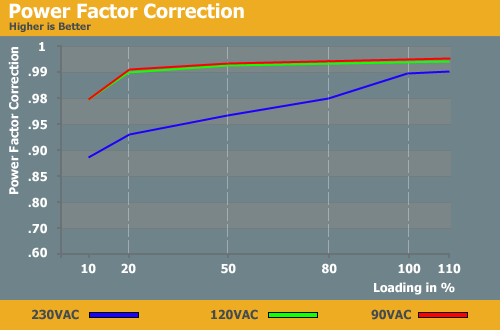
The power factor correction is very satisfying with more than .99 at lower input voltages.
Temperatures, Fan Speed, and Acoustics
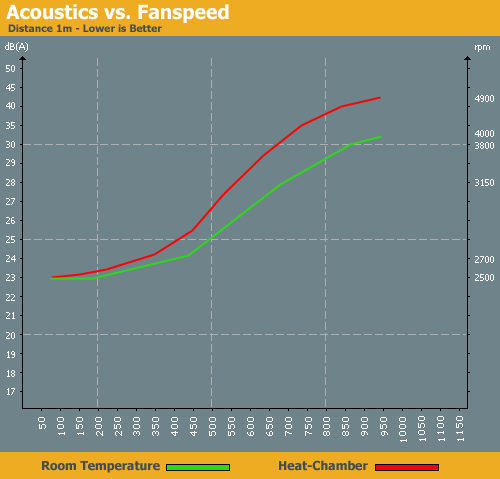
If you're buying a PCP&C power supply, you should not plan on silent computing - there just isn't any power supply in the lineup that can qualify as silent. PCP&C units always have excellent airflow, but that means they are a little above the average noise-levels. We were surprised by the 23dB(A) for starters, however, and even more surprising is that the noise-levels only increase to a still acceptable level of 25dB(A) under medium loads of 500W. When the unit is loaded, the fan speed reaches up to 4000RPM under room temperature and noise levels become more noticeable, though it's nice to see that the speed is just 900RPM more at 50°C in the heat chamber. The noise levels are in general not as annoying as we remember from the 1200W version of this series, but they are clearly audible.
Conclusion
With the Turbo Cool 860W, PCP&C went with a completely different design compared to their other Turbo Cool models. We have already discussed the old Turbo Cool design, and while it may remain a topic to argue about we'll put it behind us and simply state that we really like the new design of the 860W model. The new topology allows air to reach the important parts of the unit and it comes with a shorter chassis. We were surprised by the design since it is quite different from normal topologies, but it works just as well as other approaches even if the components are arranged differently. The changes do allow better cooling for the most critical components, and areas that don't get as hot (i.e. the input filtering stage) don't get as much airflow. There is very little with the design that we can fault.
The build quality is again very good, as we have come to expect from PCP&C. The chosen components are all very high quality, such as the Hitachi capacitor. PCP&C states an MTBF of 200,000 hours, which is definitely a long time. Unfortunately, we cannot provide our readers with any confirmation of the MTBF right now, but since we will be using this power supply in future case tests we will be running it for quite some time and we'll be sure to inform our readers of any problems we encounter. Well-chosen components are also responsible for the good overall test results. The output stability of the 12V rail is very good, coming within 2% of regulation.
The three small potentiometers on the bottom of the power supply are reachable during operation and provide an interesting addition; however, we're not sure they're actually useful. The potentiometers come set at their maximum values, and can only rotate in one direction. Unfortunately, this direction will lower the voltage instead of increasing it. The second problem is that users will not be able to read the voltage as they make adjustments, which makes this function pretty much useless. We could read the results with our Chroma, but when this PSU is running in a PC case it will be difficult for the user to read the data with a scope or voltmeter. The fact that you can only lower the voltage does not really help, unless you happen to receive a unit that's overvolted (which is unlikely).
Efficiency-wise, this power supply is one of the best we have seen. It is equal to the Zippy Serene we tested last year, as well as the "be quiet!" Dark Power PRO (Ed: Worst name ever?) we will review in an upcoming roundup. At 230VAC, we measured 88%, which is an extremely impressive result. At lower input voltages of 90VAC and 120VAC, this unit still reaches up to 84% and 85% efficiency, respectively - again good results. We are surprised that the standby efficiency isn't as good as the operating efficiency, however - you may want to turn off the main switch when you aren't using your PC if you want to be properly green.
As already stated on the acoustic page, most users that buy high-end units like the Turbo Cool do not expect a silent power supply. PCP&C has always taken care to provide a healthy power supply first and this can be only done with adequate airflow. We weren't particularly bothered by the noise with this model, however, as it is quieter than the other Turbo Cool units we've tested.
As always, PCP&C provides a 7-year warranty for their power supply. We're not sure how that works with the 200,000 MTBF, as even running 24/7 for ten years wouldn't reach half that figure, but that's apparently a testament of their PSU quality.
The Turbo Cool 860 is not out yet but it's already shipping to retailers and will be available soon. On the PCP&C website, we found a price tag of $270 - a hefty price for an 860W power supply. We unfortunately couldn't find European prices right now, but at the current exchange rate it would cost 183 EUR, which is not quite as bad (assuming final prices match the current US MSRP). On the other hand, price and quality often go hand in hand, and PCP&C earned our Gold Editors' Choice award with their Silencer 750 Quad last year; the 860W Turbo Cool looks to continue that legacy in 2008. We'll be looking at plenty of contenders, but at present PCP&C has set the bar quite high.







